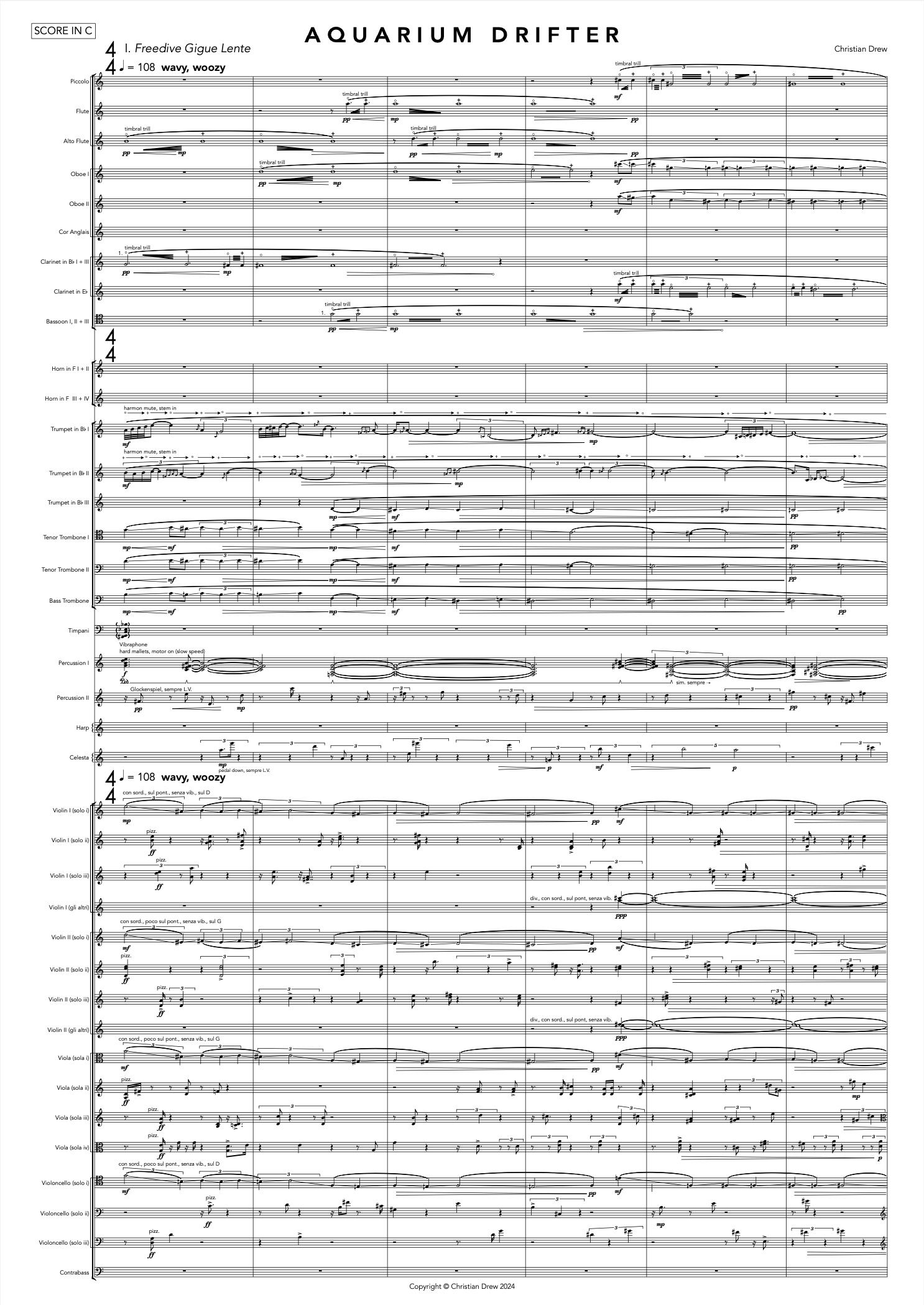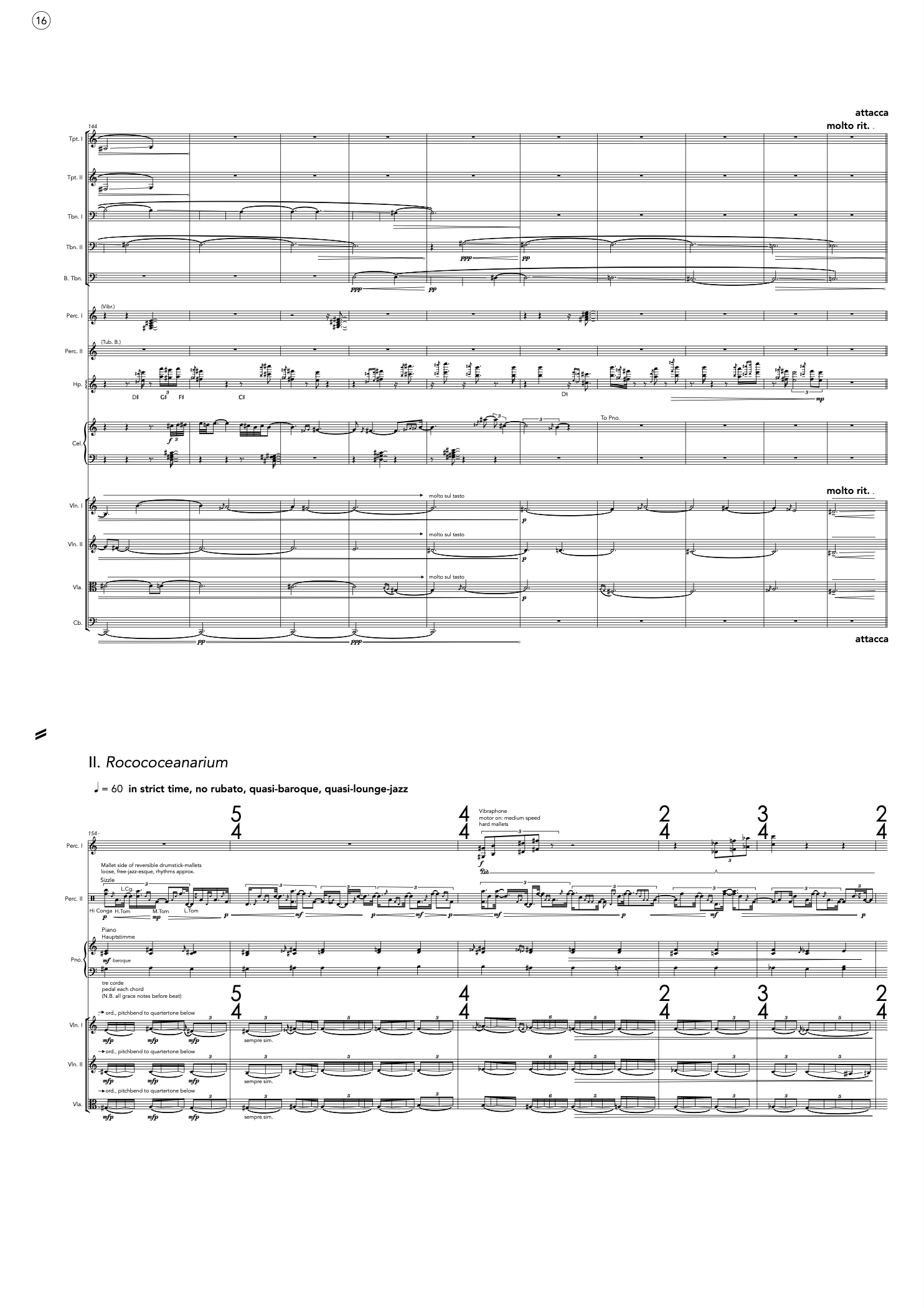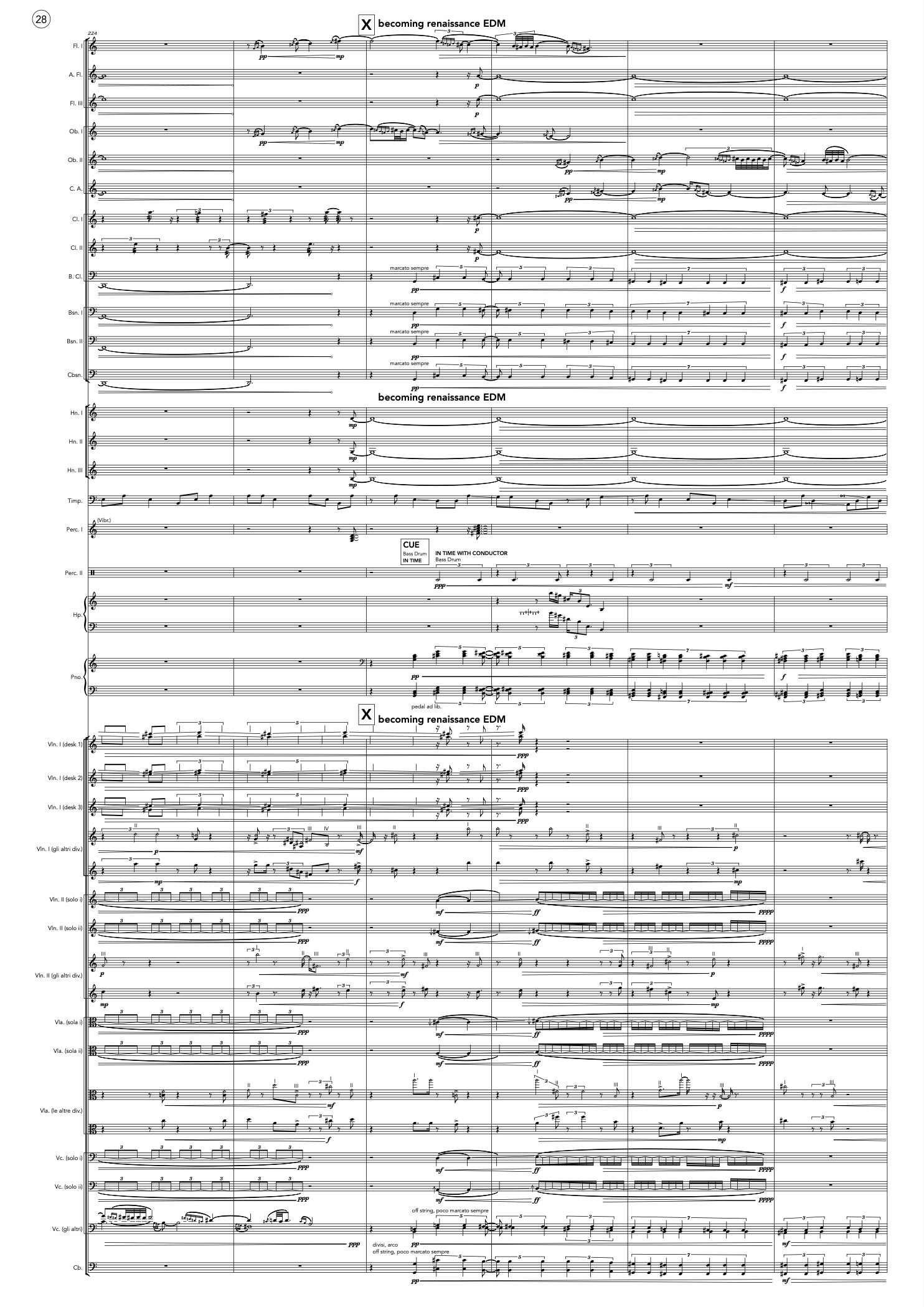AQUARIUM DRIFTER 2024
symphony orchestra [12’30”]
I. Freedive Gigue Lente (excerpt)
II. Rocococeanarium (excerpt)
III. Subtropicali Antiquarium (excerpt)
IV. Sunset Over the Super Sewer (excerpt)
view score
![]()
![]()
![]()
symphony orchestra [12’30”]
I. Freedive Gigue Lente (excerpt)
II. Rocococeanarium (excerpt)
III. Subtropicali Antiquarium (excerpt)
IV. Sunset Over the Super Sewer (excerpt)
view score



Aquarium Drifter began life under a very different title. As Double Chorus, it was Christian Drew’s three-minute creation for the 2020/21 LSO Panufnik Composers Scheme workshops: a diptych of sleazy harmonies and timbres and floridly ornamented melody. Invited to further develop his ideas, he adapted the three-minute miniature into the first of four short movements of a longer piece, which took the title of Aquarium Drifter.
Reflecting on the musical qualities of the original Double Chorus, Drew was inspired to pursue more deeply its destabilised, floating soundworld. This led him to the idea of aquariums, or ‘aquarium-adjacent things’, as he puts it. Specifically, these include woozy, lounge-style jazz; the muffled (perhaps even submerged) sounds of a Hawaiian guitar; the sun setting over the Thames Tideway construction site in Bermondsey, south London; and the watery, reverb-heavy doowop of The Flamingos.
At the same time, working with the LSO pulled Drew in another direction, towards the sounds of the existing Classical and Baroque repertoire. This is music ‘that the LSO play incredibly well and are extremely knowledgeable about’, he says, but which in its formal principles of poise and balance sits some distance away from the heady sounds of hotel lobby pianos and slack-key guitars on the beach.
The surrealistic juxtaposition is reflected in the Hunter S Thompson-meets-Henry Purcell portmanteaus of Drew’s movement titles: ‘Freedive Gigue Lente’, ‘Rocococeanarium’, ‘Subtropicali Antiquarium’ and ‘Sunset Over the Super Sewer’. The second of these in particular – a mix of wobbly continuo and conga/tom-tom obbligato – exemplifies the unique mix. The third includes the first violins divided to create a six-part ‘slide guitar’ effect; Baroque ornaments and suspensions in the flutes, oboes and trumpets; and – pushing the genre boundaries still further – a passage towards the end of the movement marked ‘becoming renaissance EDM’, with electronic dance music-like piano chords and a thumping bass drum.
For his final movement, Drew takes an off-kilter romantic turn, with dreamy string chords suspended beneath a mellifluous marimba solo. When it is joined later by vibraphone, harp and celeste, this quartet leaves the rest of the orchestra behind – although the music stops abruptly here, it is with the sense that these four could continue, swaying slightly in the current, for ever.
Programme notes copyright Tim Rutherford-Johnson 2024
Reflecting on the musical qualities of the original Double Chorus, Drew was inspired to pursue more deeply its destabilised, floating soundworld. This led him to the idea of aquariums, or ‘aquarium-adjacent things’, as he puts it. Specifically, these include woozy, lounge-style jazz; the muffled (perhaps even submerged) sounds of a Hawaiian guitar; the sun setting over the Thames Tideway construction site in Bermondsey, south London; and the watery, reverb-heavy doowop of The Flamingos.
At the same time, working with the LSO pulled Drew in another direction, towards the sounds of the existing Classical and Baroque repertoire. This is music ‘that the LSO play incredibly well and are extremely knowledgeable about’, he says, but which in its formal principles of poise and balance sits some distance away from the heady sounds of hotel lobby pianos and slack-key guitars on the beach.
The surrealistic juxtaposition is reflected in the Hunter S Thompson-meets-Henry Purcell portmanteaus of Drew’s movement titles: ‘Freedive Gigue Lente’, ‘Rocococeanarium’, ‘Subtropicali Antiquarium’ and ‘Sunset Over the Super Sewer’. The second of these in particular – a mix of wobbly continuo and conga/tom-tom obbligato – exemplifies the unique mix. The third includes the first violins divided to create a six-part ‘slide guitar’ effect; Baroque ornaments and suspensions in the flutes, oboes and trumpets; and – pushing the genre boundaries still further – a passage towards the end of the movement marked ‘becoming renaissance EDM’, with electronic dance music-like piano chords and a thumping bass drum.
For his final movement, Drew takes an off-kilter romantic turn, with dreamy string chords suspended beneath a mellifluous marimba solo. When it is joined later by vibraphone, harp and celeste, this quartet leaves the rest of the orchestra behind – although the music stops abruptly here, it is with the sense that these four could continue, swaying slightly in the current, for ever.
Programme notes copyright Tim Rutherford-Johnson 2024
“If the programme notes suggested we were going to get nothing but similar textures at greater length thereafter – the dreaded “sound world” always suggests the triumph of atmosphere over substance – Christian Drew’s Aquarium Drifter offered an immediate corrective. Though Drew is fond of terms like “noodling” and “woozy”, there was a clear structure to this life aquatic, which took the shape of a continuous sinfonietta, and far from all the music of the past lying at the bottom of an iridescent lake, one particular neobaroque specimen seemed to break the surface in full sail. Bewitching and original “sound world”, too; the brass did Drew proud, and the woodwind managed to sound at times like a saxophone ensemble. I smiled from start to finish, and would happily have listened to the whole work again.” - The Arts Desk
“Drew’s Aquarium Drifter lived up to its name. Sounds blurred and rippled like water, conjured by bending pitches, woozy glissandos and pizzicato droplets. There was a joy in its laid-back warmth and an appealing freshness to the orchestration” - The Times
Commissioned for the London Symphony Orchestra through the LSO Discovery Panufnik Composers Scheme, supported by The Helen Hamlyn Trust
“Drew’s Aquarium Drifter lived up to its name. Sounds blurred and rippled like water, conjured by bending pitches, woozy glissandos and pizzicato droplets. There was a joy in its laid-back warmth and an appealing freshness to the orchestration” - The Times
Commissioned for the London Symphony Orchestra through the LSO Discovery Panufnik Composers Scheme, supported by The Helen Hamlyn Trust
email: music@christiandrew.com
© Christian Drew 2025